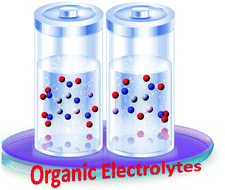Li@organic superhalogens: possible electrolytes in Li-ion batteries†
Abstract
Inorganic superhalogens are commonly used as anionic counterparts in Li-ion batteries. In an endeavour to prepare better electrolytes, we have modelled the anionic part with different organic heterocyclic-based superhalogens. First principles calculations on those organic superhalogens reveal that the Li-binding energy is at par with that of the Li-salt of a common electrolyte. Out of five different halogen free organic heterocycles, Li[C3BN2(NO2)4] and Li[C2BNO(NO2)3] are found to be mostly suitable as electrolytes in Li-ion batteries. Molecular dynamics simulation studies on C2BNO(NO2)3−, C3BN2(NO2)4−, Li[C2BNO(NO2)3] and Li[C3BN2(NO2)4] also reveal that the structures are dynamically stable.



 Please wait while we load your content...
Please wait while we load your content...